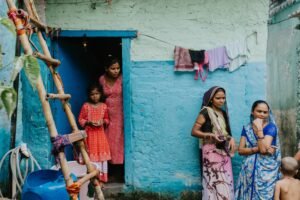
Articles
Legal Tangle: The Clash Between Reproductive Rights and Child Protection Laws...

This article aims to examine the interplay of laws governing reproductive rights and child rights in India. It demonstrates that the full benefits of the MTP Act, which governs the termination of pregnancy in an otherwise criminalised framework, are reduced because of contradictions with the POCSO Act in terms of adolescents getting access to safe healthcare, dignity, autonomy and privacy. Instead, the legal framework should centre the best interests of children regarding their sexual and reproductive needs and choices.
Legal Framework
Indian laws on abortion are generally considered progressive. However, despite it being a crucial sexual and reproductive health (SRH) service, access to abortion remains difficult for Indian women. Abortion is not provided on request under the Medical Termination of Pregnancy (MTP) Act, 1971. The Indian Penal Code, 1860 lists the punishments for offences related to causing miscarriage (Sections 312-316). The MTP Act, on the other hand, is a provider protection law, meaning that it lays down the specific circumstances under which a pregnancy may be terminated lawfully by a Registered Medical Practitioner (RMP).
The MTP Amendment Act of 2021 aims to secure women’s access to safe, lawful and good quality abortion care. In line with advancements in medical technology, it allows safe abortions upto higher gestational limits. It also safeguards the dignity, autonomy and confidentiality of these women. It provides protection from prosecution for termination of pregnancies up to 20 weeks for women with the opinion of one RMP, and up to 24 weeks with the opinion of two RMPs for vulnerable classes of women, to the effect that continuance of the pregnancy will
- Involve a risk to the life of the pregnant woman
- Carry a risk of grave injury to her physical or mental health
- There is a substantial risk that if the child were born, it would suffer from a serious physical or mental ‘abnormality’
The MTP Rules of 2021 extend the upper gestational limit to 24 weeks for minors, recognising their heightened vulnerability resulting from late detection, difficulty in reporting, and increased health risks.
Several Supreme Court decisions have acknowledged the difficult experiences of women while navigating the complex medico-legal maze surrounding abortion. These rulings significantly broadened the scope of protections, going so far as to recognize abortion as a fundamental right based on the rights to equality, privacy, non-discrimination, bodily autonomy, health, dignity and reproductive choice. However, there has been an inconsistent application of this position, demonstrating a departure from centring the choice and lived reality of the pregnant person in question.
Barriers to access
According to a recent report by the United Nations Population Fund, a staggering 67% of abortions in India are unsafe, and 78% are conducted outside health facilities. These numbers indicate the various barriers that persist in the access to safe abortions for Indian women. It is widely recognized that legal restrictions on abortion impede access to safe services, increase the risk of maternal and child mortality, and the risk of unwanted births in families unprepared to care for more children. These barriers are compounded by the lack of reliable information and the strong stigma around sexuality. Other intersections of marginalisation such as caste, class, geographical location, disability and poverty also play a role. In the case of adolescents below the age of consent – which is set at 18 in India – access to SRH services is further limited by additional requirements embedded within the MTP Act and their interplay with the Protection Of Children from Sexual Offences (POCSO) Act, 2012.
Criminalisation and Mandatory Reporting
Despite the legal bar, adolescent sexual activity remains prevalent in India and often results in unwanted pregnancies. Since any and all sexual activity involving a minor constitutes an offence under the POCSO Act, the responsibility of mandatory reporting of such cases to the police lies with the RMP. Failing to report any apprehension of the same is also an offence (Sections 19, 21 of the POCSO Act). This necessitates the involvement of the police and triggers criminal prosecution as an inevitable consequence of SRH services being used by a minor.
This framing of the mandatory reporting obligations is punitive and hinders confidential access to SRH services. For instance, minors engaging in consensual sexual encounters may be unwilling to prosecute their partners, or cases of incest where guardians may be inclined to protect the perpetrator from prosecution. Such requirements go against the Independent Expert for the UN Secretary General’s Study on Violence Against Children’s recommendation that mandatory reporting systems should be framed as a “help-oriented service offering public health and social support rather than as being primarily punitive.” Pertinently, the MTP Act imposes no consequences on an RMP who denies the service to a minor due to the chilling effect of penal laws or personal biases against abortion.
Best interests of the adolescent
The ‘best interests’ standard, which is the overarching guiding principle for all actions concerning children below the age of 18 years, emphasises the importance of considering the unique circumstances and needs of each minor. The MTP Act mandates recording the consent of the pregnant person, and maintaining their privacy. However, these full protections of the MTP Act are unavailable to adolescents, despite being in their best interests. Legally, minors are not qualified to provide consent for sexual activity, and cannot authorise an abortion for themselves. A pregnant minor requires the written consent of their guardian as a prerequisite under the MTP Act to secure a lawful abortion. Moreover, the mandatory reporting requirement under the POCSO Act discussed above puts an obligation on the RMP to report the matter to the police. The benefits of consent and privacy are thus not available to a minor seeking to terminate their pregnancy.
The guardian consent clause is based on the assumption that parents will always make decisions in the best interests of their children. However, in the cases of minors whose guardians are unavailable, incapacitated or unwilling to consent, or when there is a conflict between the best interests of the minor and the opinion of the guardian, these requirements fail to prioritise the safety, well-being, and autonomy of young individuals. For instance, in cases of incest, where legal proceedings could lead to the implication of another family member, or where consent of a parent is driven by misinformation about reproductive health and available legal options, the mandatory guardian’s consent requirements casts doubt on the presumption that guardians would always act in the best interest of the minor. International treaty bodies including the UN, as well as the National Health Mission (NHM), have stressed the critical link between privacy and health, and the need for comprehensive education on SRH, bearing in mind the evolving capacities of children.
Evolving capacities of the child
It is evident that disqualifying all minors from participating in decisions affecting their health may not be in their best interests. The Juvenile Justice Act (JJ Act) enshrines ‘Principle of Participation’ as a fundamental guiding principle governing the treatment of children by law. While protecting children from sexual violence is a key obligation of the state, the UN Committee on the Rights of the Child (CRC) has urged states to balance protection and evolving capacities and “avoid criminalizing adolescents of similar ages for factually consensual and non-exploitative sexual activity.” This suggests that evolving capacities must be understood with a view to safeguard and protect the rights of the child. However, the irony in the treatment of children under the Indian legal framework presents a paradoxical situation.
Section 15 of the JJ Act has a provision to try children in conflict with law aged between 16-18 years as adults, following an assessment of their physical and mental capacity to commit a heinous offence. This implies that the law recognises the evolving and varying capacity of children over a certain age to make more reasoned decisions, going as far as to hold them accountable at par with adults. However, a similar exception is not made in the law to recognise their capacity for autonomous, informed and evolved decision-making in SRHR matters. If adolescents can be held criminally responsible as adults for heinous offences, they can certainly be deemed responsible enough to make decisions about their reproductive choices. Ironically, many cases under the JJ Act prosecute adolescent boys involved in sexual activity with their female counterparts. Despite gender neutrality being enshrined in the POCSO Act, the web of criminalisation surrounding this phenomenon has resulted in legally unintended adverse consequences for both boys and girls in highly gendered ways.
Conclusion
The current clash between the two important laws governing adolescent sexual behaviour end up posing serious risks to the health and survival of adolescents, contributing to higher incidences of unsafe abortions, and undermining the public health objectives of the state. The way ahead lies in moving away from medicalised state control over reproductive choices and upholding the principles of reproductive justice to facilitate access to abortion for adolescents, keeping in mind their special needs and best interests.











